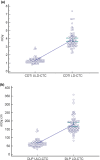Ultra-low dose CT colonography with automatic tube current modulation and sinogram-affirmed iterative reconstruction: Effects on radiation exposure and image quality
- PMID: 30586479
- PMCID: PMC6333183
- DOI: 10.1002/acm2.12510
Ultra-low dose CT colonography with automatic tube current modulation and sinogram-affirmed iterative reconstruction: Effects on radiation exposure and image quality
Abstract
Objective: To assess the radiation dose and image quality of ultra-low dose (ULD)-CT colonography (CTC) obtained with the combined use of automatic tube current (mAs) modulation with a quality reference mAs of 25 and sinogram-affirmed iterative reconstruction (SAFIRE), compared to low-dose (LD) CTC acquired with a quality reference mAs of 55 and reconstructed with filtered back projection (FBP).
Methods: Eighty-two patients underwent ULD-CTC acquisition in prone position and LD-CTC acquisition in supine position. Both ULD-CTC and LD-CTC protocols were compared in terms of radiation dose [weighted volume computed tomography dose index (CTDIvol ) and effective dose], image noise, image quality, and polyp detection.
Results: The mean effective dose of ULD-CTC was significantly lower than that of LD-CTC (0.98 and 2.69 mSv respectively, P < 0.0001) with an overall dose reduction of 63.2%. Image noise was comparable between ULD-CTC and LD-CTC (28.6 and 29.8 respectively, P = 0.09). There was no relevant difference when comparing image quality scores and polyp detection for both 2D and 3D images.
Conclusion: ULD-CTC allows to significantly reduce the radiation dose without meaningful image quality degradation compared to LD-CTC.
Keywords: automated tube current modulation; computed tomographic colonography; computed tomographic colonography, technique; dose reduction; iterative reconstruction techniques; radiation dose.
© 2018 The Authors. Journal of Applied Clinical Medical Physics published by Wiley Periodicals, Inc. on behalf of American Association of Physicists in Medicine.
Figures





Similar articles
-
Computed tomography colonography and radiation risk: How low can we go?World J Gastrointest Endosc. 2021 Mar 16;13(3):72-81. doi: 10.4253/wjge.v13.i3.72. World J Gastrointest Endosc. 2021. PMID: 33763187 Free PMC article. Review.
-
Evaluation of dose reduction and image quality in CT colonography: comparison of low-dose CT with iterative reconstruction and routine-dose CT with filtered back projection.Eur Radiol. 2015 Jan;25(1):221-9. doi: 10.1007/s00330-014-3350-3. Epub 2014 Aug 6. Eur Radiol. 2015. PMID: 25097128
-
Sub-millisievert CT colonography: effect of knowledge-based iterative reconstruction on the detection of colonic polyps.Eur Radiol. 2018 Dec;28(12):5258-5266. doi: 10.1007/s00330-018-5545-5. Epub 2018 Jun 8. Eur Radiol. 2018. PMID: 29948063
-
Validation of dual-source single-tube reconstruction as a method to obtain half-dose images to evaluate radiation dose and noise reduction: phantom and human assessment using CT colonography and sinogram-affirmed iterative reconstruction (SAFIRE).J Comput Assist Tomogr. 2012 Sep-Oct;36(5):560-9. doi: 10.1097/RCT.0b013e318263cc1b. J Comput Assist Tomogr. 2012. PMID: 22992607
-
Computed tomography colonography in 2014: an update on technique and indications.World J Gastroenterol. 2014 Dec 7;20(45):16858-67. doi: 10.3748/wjg.v20.i45.16858. World J Gastroenterol. 2014. PMID: 25492999 Free PMC article. Review.
Cited by
-
The clinical performance of ultra-low-dose shoulder CT scans: The assessment on image and physical 3D printing models.PLoS One. 2022 Sep 26;17(9):e0275297. doi: 10.1371/journal.pone.0275297. eCollection 2022. PLoS One. 2022. PMID: 36155982 Free PMC article. Clinical Trial.
-
Computed tomography colonography and radiation risk: How low can we go?World J Gastrointest Endosc. 2021 Mar 16;13(3):72-81. doi: 10.4253/wjge.v13.i3.72. World J Gastrointest Endosc. 2021. PMID: 33763187 Free PMC article. Review.
-
Achieving sub-millisievert CT colonography for accurate colorectal tumor detection using smart examination protocols: a prospective self-controlled study.Abdom Radiol (NY). 2025 Mar;50(3):1079-1089. doi: 10.1007/s00261-024-04557-5. Epub 2024 Sep 14. Abdom Radiol (NY). 2025. PMID: 39276190 Free PMC article.
-
EXTRACOLONIC FINDINGS-IDENTIFICATION AT LOW-DOSE CTC.Radiat Prot Dosimetry. 2021 Oct 12;195(3-4):188-197. doi: 10.1093/rpd/ncab054. Radiat Prot Dosimetry. 2021. PMID: 33855447 Free PMC article.
-
Single CT Appointment for Double Lung and Colorectal Cancer Screening: Is the Time Ripe?Diagnostics (Basel). 2022 Sep 27;12(10):2326. doi: 10.3390/diagnostics12102326. Diagnostics (Basel). 2022. PMID: 36292015 Free PMC article. Review.
References
-
- Vining DJGD, Bechtold RE, Scharling ES, Grishaw EK, Shifrin RY. Technical feasibility of colon imaging with helical CT and virtual reality. Am J Roentgenol. 1994;162:S104.
-
- von Wagner C, Ghanouni A, Halligan S, et al. Patient acceptability and psychologic consequences of CT colonography compared with those of colonoscopy: results from a multicenter randomized controlled trial of symptomatic patients. Radiology. 2012;263:723–731. - PubMed
-
- Cohnen M, Vogt C, Beck A, Andersen K, Heinen W, vom Dahl S, et al. Feasibility of MDCT Colonography in ultra‐low‐dose technique in the detection of colorectal lesions: comparison with high‐resolution video colonoscopy. AJR Am J Roentgenol. 2004;183:1355–1359. - PubMed
-
- Chang KJ, Yee J. Dose reduction methods for CT colonography. Abdom Imaging. 2013;38:224–232. - PubMed
MeSH terms
LinkOut - more resources
Full Text Sources
Medical
Research Materials
Miscellaneous

